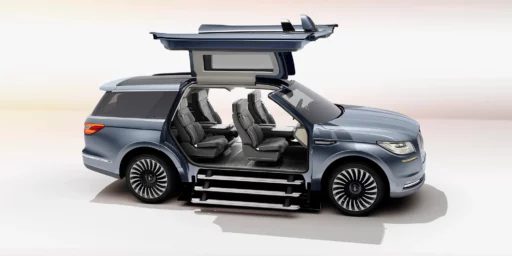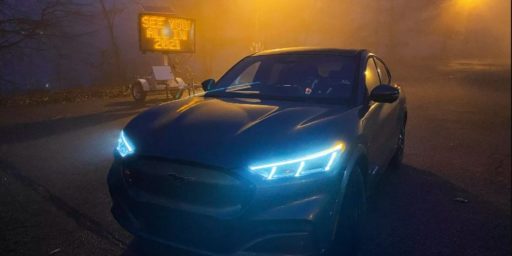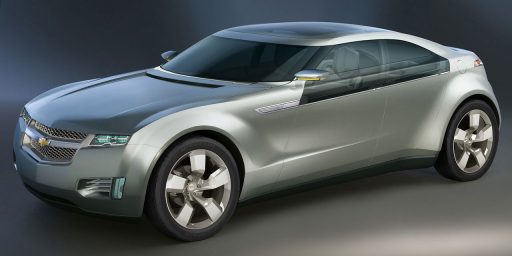Heavier Vehicles Need Stronger Guardrails
Our infrastructure was not designed for what most Americans drive today.

Slate (“A 7,000-Pound Car Smashed Through a Guardrail. That’s Bad News for All of Us.“):
It’s a nightmare situation on a highway: Your car hits a patch of ice and starts to skid. Unable to regain control, you panic as you veer toward the roadway’s edge.
In emergencies like this, guardrails provide a failsafe. As explained in a federal memo, a guardrail will “deflect a vehicle back to the roadway [or] slow the vehicle down to a complete stop.” Your car will probably be damaged, but guardrails can prevent something much worse.
But some modern vehicles can instead smash through these guardrails, new research demonstrates, sending their passengers hurtling toward a ditch, cliff, or whatever is on the other side. The problem is that thousands of miles of guardrails installed alongside American highways were designed decades ago, when vehicles were much lighter than the behemoths that increasingly dominate the U.S. car market.
These pieces would be more useful without the sneering language. While I get that large vehicles have negative externalities, there are all manner of reasons why they’re becoming increasingly popular. Including the fact that their prevalence puts those in smaller vehicles at a disadvantage on the road. What makes sense in Boston doesn’t necessarily make sense in Bismark or even Birmingham.
Regardless, the facts are what they are:
And cars are only getting heavier: Bulkier electrified versions of big cars are poised to arrive in the years ahead. The risk of huge vehicles tearing through guardrails is yet another reason to expect American car bloat to augur an expensive, and dangerous, roadway future.
Again, “bloat” inserts sneering judgment into what would otherwise be a scientific analysis.
The new study comes from the University of Nebraska, which received funding from the U.S. Army to examine the impact of electric vehicles on guardrails. The university is a natural location for such research; its Midwest Roadside Safety Facility designed and tested the metal barriers known as the Midwest Guardrail System that are a familiar sight along American highways. The MGS is a beam with a dip running horizontally in the middle—if you think of a guardrail, you’re probably picturing one. “It’s the most frequently used guardrail system, because it’s the cheapest to install and maintain,” said University of Nebraska engineering professor Cody Stolle, noting that all 50 states use it.
The current version of MGS was developed to withstand cars weighing a maximum of 5,000 pounds, but many of today’s SUVs and trucks exceed that threshold. A Cadillac Escalade, for instance, now weighs over 6,200 pounds, and the latest model of the Ford F-150, the most popular vehicle in America, can tip the scales at almost 5,700 pounds. You don’t really want to hit a guardrail with a vehicle like that, but electrification can make things even dicier. Electric cars often weigh around 30 percent more than a gas-powered counterpart, because big vehicles require enormous batteries to propel them hundreds of miles between charges. The goliath-like GMC Hummer EV weighs a staggering 9,083 pounds, 2 tons more than a gas-guzzling H3.
Again with the social commentary. While I don’t get the attraction of the Hummer, it’s not even a particularly large vehicle compared to a full-sized pickup truck or SUV. But, yes, the electric version is staggeringly heavy.
In their study, the University of Nebraska researchers wanted to see whether guardrails can withstand a collision with a big, modern EV. Their answer: No.
Last October, the researchers directed a passengerless 2022 Rivian R1T truck weighing around 7,000 pounds toward an MGS guardrail at 62 mph and a 25-degree angle, reflecting common highway crash conditions. The Rivian demolished the guardrail, passing through it before striking a concrete barrier that the researchers had installed as a backstop.
The silver lining, Stolle told me, was that the Rivian seemed capable of protecting passengers in that test. “The damage to the interior of the vehicle was very low,” he said, “and the occupant risk in that scenario would not be cause for alarm.” But he noted that in the real world, a guardrail is much more likely to be placed next to a steep dropoff than a concrete barrier. If a car penetrates a guardrail and tumbles down an incline, passengers would face far greater danger.
Hitting a guardrail at 62mph is definitely not a good idea. Doing so in a particularly heavy vehicle, apparently, even more so. Because physics.
It’s worth highlighting that this study isn’t really about the merits of EVs. After all, you can buy an EV that weighs less than 5,000 pounds. You just can’t electrify your favorite already-large car—or even buy a hulking gas-powered car—and expect guardrails to work as intended. “Weight is a universal problem; it is not unique to electric vehicles,” Stolle said. “We have similar concerns about the compatibility of the biggest gas-powered cars with our guardrail system.” The 6,700-pound Chevrolet Silverado 1500 already weighs too much, based on the result from this research, and the 8,500-pound Silverado EV weighs even more.
A caveat: This is only one study, using a single truck. Still, its implications are troubling, to say the least. As the average American car grows larger, today’s guardrails could fail in more crashes, creating a new highway hazard and worsening an already dire road safety crisis.
Of course, crashes involving guardrails are not the only variety. Indeed, I strongly suspect they’re not the most common variety. We’ve known for years that drivers and passengers in bigger vehicles are much more likely than smaller ones to survive vehicle-on-vehicle crashes. And that, smaller vehicles—not to mention cyclists and pedestrians—are at a severe disadvantage against larger ones.
Ensuring that tomorrow’s cars do not slam through metal barriers and fly off the highway would require a wholesale upgrade of the nation’s guardrail installations, which Stolle estimated to cover at least 50,000 miles. Assuming a materials cost of $30 per foot, replacing all MGS guardrails could easily hit $8 billion, not including installation expenses that would drive the price tag much higher. (Retrofits could be less expensive, but Stolle said it’s too soon to know if they would be feasible.) To put that figure in perspective, $8 billion exceeds North Carolina’s entire annual transportation expenditures, and is almost six times Maryland’s transportation maintenance budget.
In a statement, a Federal Highway Administration spokesperson showed little interest in assuming responsibility for a future guardrail overhaul, saying that “states and local governments are responsible for properly selecting, installing, maintaining, and replacing roadside safety hardware, including guardrails,” and requesting that further questions be directed to them.
Unless there’s a spate of “behemoth” vehicles crashing through guardrails, I suspect this upgrade won’t happen. And that, if it does, it’ll be a gradual one, with sturdier versions replacing existing ones a the most dangerous locations and as old ones were due for replacement.
More sneering:
Who will ultimately foot the bill for reinforced guardrails? You, in all likelihood. There is ample precedent, since car bloat is already known to worsen a bevy of societal problems that range from pedestrian deaths to climate change to roadway erosion. Because the federal government has not imposed taxes to address those costs, all Americans bear the financial burdens of oversize vehicles—no matter how they travel.
Again, there’s no denying that there are negative externalities associated with “oversize” vehicles. But that’s more true of commercial vehicles than ordinary passenger cars. Our one-day delivery culture means that giant trucks are on the roads—including neighborhood streets—constantly.
Those who own larger vehicles do, of course, pay taxes to do so. They’re more expensive to purchase, in most cases, than comparable smaller models. Which means higher sales and property taxes. They consume more fuel, which means higher fuel taxes. Whether these are enough to offset the externalities, though, I haven’t the foggiest.
Car bloat is not a uniquely American problem; SUV sales are rising around the world, notably in Europe. Places like France, Norway, and the District of Columbia have enacted policies that force owners of the biggest cars to pay fees that at least partially compensate for the costs imposed on everyone else (and potentially nudge consumers toward smaller, less damaging models). But Congress and the Department of Transportation have shown no signs of following suit.
The United States is a vast country that, for a whole variety of reasons, requires people to be in their cars a whole lot more than is the case in France, Norway, or DC. It’s not at all shocking that this has led us to prioritize comfort over efficiency. Spikes in gas prices will temporarily cause panic buying of smaller cars but the demand for larger ones always rebounds.
It would be foolish, indeed, for the people’s representatives to punish them for this choice. But it would absolutely be reasonable to incentivize the purchase of more fuel-efficient vehicles. As, it turns out, we do. (Although, apparently, EVs come with the hidden danger of guardrail failure. The horrors!) And, yes, to the extent “behemoth” vehicles impose negative externalities, it’s reasonable to mitigate them, whether through design choices (bumper placement, more cameras to provide better visibility, etc.) or taxation.
In the meantime, a prisoner’s dilemma is catalyzing the shift toward vehicular enormity, prodding even those who prefer a modest-size car to get a bigger one simply to avoid being at a disadvantage on the road.
Again, this is not an unreasonable choice! In the linked piece, about a kerfuffle over a recommendation that parents get their teen drivers newer, bigger cars because they provide more crash protection, someone asks, “What about people outside the car?” That’s a reasonable question from a public policy standpoint but decidedly not the biggest consideration for said parents.
Unless federal policymakers finally acknowledge car bloat’s dangers, the result will be a dirtier, deadlier, and more expensive transportation network. And a lot of busted guardrails, too.
It turns out that the sneering was the point and the concern over guardrails merely an excuse to deliver it.






You’re dithering James. The rate of deaths on US roads has increased over the last few years, while in the rest of the developed world the death rate continues to decrease. Pearl clutching and saying, by saying oh dear what can we do, people want… is burying your head in the sand.
With regard to the guard rails and heavy vehicles, create a reserve to upgrade them funded by an excise tax on vehicles with a curb weight of over 5000#, $1 per pound collected annually sounds about right. Don’t want to pay the tax, get a vehicle that has a curb weight of less than 5000#.
Now you’ll point out, the political process, but that’s a different issue.
As we switch over to electric vehicles, we are going to have to replace the gas tax with something else. After all, these taxes pay for the maintenance of roads, up to 50% or more in some states, and electric vehicles use the roads as much as gas powered ones, and given their extra weight, impact them more. In an ideal but perhaps impractical scenario, we would have a mileage tax which is indexed to the weight of the vehicle. Tracking the mileage may very well be too onerous though, so I think a good compromise would be an annual tax based on vehicle weight. For added measure, vehicles that are more likely to get into accidents and/or kill or seriously injure pedestrians and occupants of other vehicles should also have a hefty premium.
The only down side I can see with this is that the rice rockets that race each other on the Baltimore beltway and that have caused so many accidents tend to be small and light. If we could come up with a stupidity tax on top of everything else, we would have achieved perfection.
Parking garages may not be able to handle the weight of contemporary vehicles:
https://www.curbed.com/2023/04/parking-garage-collapse-heavier-electric-vehicles-suvs.html
You think someone should tell them that trucks weigh even more? Seriously, I thought it wasn’t that bad of an article and the style is just that of modern young people. When it comes time to replace them just upgrade them if it turns out to be an issue. Besides, if you remember your physics its velocity squared and driving 62 on most of our highways means you are the slow car.
Steve
@Sleeping Dog: But the main reason vehicles are topping 5000 pounds is the push toward electrification. Most gasoline-powered SUVs are well under 5000 pounds. Really, the only ones that aren’t are the truly large, truck-based ones like the Chevy Suburban. My 3-row Mazda CX-9 only weighs 4400.
@Kingdaddy: Yup. Another unintended consequence of electric. And, to be clear, I think electric—and certainly hybrid—is the right direction.
@steve: He’s not that young! He doesn’t list dates for his college degrees but he’s been in the workforce for at least 24 years now.
@James Joyner:
Sure, but that doesn’t change reality. Heavier cars do more road damage and so should pay more in road usage fees. It just basic fairness.
Today’s electric cars don’t automatically have to top 5K. The tesla 3 in its standard configuration is only 3500 pounds. As battery technology progresses and the charging infrastructure matures (leading people to be content with, say, 200 to 250 mile ranges), I wouldn’t be surprised to see sub 3000 pound EVs available in the US.
A 1965 Cadillac Fleetwood weighed about 5,200 lb. A 2023 Hummer weighs more than 9,000 lb. Clearly, there’s a problem. Whether the problem is that some of today’s vehicles are too heavy or that our infrastructure’s margins are too small, there’s clearly a problem.
@James Joyner:
A major reason why EV’s are so heavy is that the vehicles themselves are so large and heavy. There are any number of EV’s with curb weights under 5000#
James, it’s Slate. As such your complaining about “sneering” reads as hollow as complaining about FOX talking heads telling outright lies. What did you expect? Objective journalism? Ohhh, my sweet summer child…
@Dave Schuler: Sure. But the article notes that the electric version is two tons heavier than the gas version, which would thus only be 5000 pounds. The Cadillac CT6, which was the closest analog to the Fleetwood, only weighed 4100 pounds. They stopped making it in 2020.
@Sleeping Dog: Sure, but then you have a heavy small vehicle. Even if you can coerce or cajole people into downsizing, you now have a vehicle that’s much more dangerous to the driver and passengers.
@OzarkHillbilly: I’ve been reading Slate since its launch, when I was considerably more conservative. I grant that it’s always had a bicoastal sensibility but never thought of it as a lefty analog to what Fox News has become.
@James Joyner: I don’t really know lefty v righty. What I do know is I got tired of their schtick years ago.
@OzarkHillbilly: Fair enough. They are rather infamous for Matt Yglesias-style contrarianism but I find them by-and-large useful.
@James Joyner: I read Slate fairly regularly and they do some decent reporting, but also meet their need for column inches by having boilerplate opinion-analysis pieces. Salon is the real culprit on the left when it comes to snark and slant.
Has anyone else noticed how prevalent advice columns are becoming as click-magnets. 5 out of 10 Salon articles seem to be “One Member of My Thruple Wants To Do Something Repulsive, What Should I Say?”. And here are two real pieces I just scraped form Slate: “I Always Pictured Breastfeeding My Kids. Then My Psychiatrist Recommended Against It.” and
“My Stepdaughter Hates Her Father and Me With a Passion. But She’s Still Angling for His Money.” And it seems the busiest columnist at WaPo is Ask Amy.
When I’m driving on I-80, am more worried about getting smushed between two tractor-trailers than dealing with an SUV. My defensive driving technique is a) assume people on the road around me are about to do the stupidest action possible at any point, and b) not be there.
Public radio used to host Car Talk, hosted by Tom and Ray Magliozzi. Besides a long career in car repair they had two BSes in engineering and a PhD in management. A listener called in a question. They had bought their teenage daughter a small sedan and she totaled it, so they bought her a bigger, “safer” sedan and she totaled it, so they bought her a “really safe” SUV and she totaled it – so what should they buy her next. Only time I ever heard long dead air while one of them composed a diplomatic explanation that maybe, just maybe, the car selection wasn’t the problem. The whole country is living a bigger version of her story, except it isn’t driven by crashes or safety, but by marketing. (On a political note, it’s hard to sympathize with the economic anxiety of people who buy thousands of dollars of guns and 60K+ vehicles.)
I find the tone of the article entirely appropriate. I grew up with sports cars. In that world, if it doesn’t make the car go, or make the car go faster, it’s just more pounds of stuff that can break. So many current vehicles are self parody.
@Sleeping Dog: and @MarkedMan: suggest versions of a Pigouvian tax, a tax to cover the externality costs of a product or activity. You yourself suggest crumple zones should be appropriate and bumper heights standardized with sedans. In a rational world we would do all of these things. If that makes a 9,000 lb electric Hummer (a GMC, not a sex toy) infeasible, so be it. But it’s clear we do not live in a rational world.
@Grumpy Realist:
Every time I see a “Watch Out for Motorcycles” sticker I recall that when I bought my bike years ago every biker I met told me to watch out for myself. I operated on the assumption most drivers don’t see me and some of those who do will attack me. (I did experience drivers deliberately trying to fuck with me.) I haven’t owned a bike for decades, but it’s still a good rule, especially in the Miata. Always leave yourself a way out.
@gVOR10:
My father worked for an insurance company. At some point the underwriters noticed that 60% of motorcycle claims were by people with less than a year riding, and 90% by people with less than two years. The underwriters commissioned a study including lots of parts including interviews done by psychologists. The psychologists’ part of the final report said something along the lines of, “Riders with two years or more experience are, when they are on their motorcycles, the single most paranoid group of people we’ve ever seen. They believe all the other drivers are out to hit them. We don’t know how to create that paranoia other than sticking the riders out in traffic for two years.”
Plunging through a guardrail and hurtling to your death down a ravine seems less likely than crushing a pedestrian to goo. It’s also a case where the person with the behemoth is experiencing more of the risk that their choices are creating.
I say: fuck it, let them die.
If we wanted to prevent deaths, we would be banning right-on-red and requiring all tall vehicles to be designed with sloping hoods so drivers can see pedestrians in front of them.
We can upgrade any guardrails in front of schools or something where they serve to protect people on the other side of the guardrail, but those are a very tiny percentage.
Well, there are a lot of things going on. But fundamentally, in the decade prior to Covid, we had the least amount of traffic deaths on a miles-driven basis despite all the various changes in the types of vehicles on the road. During Covid, this number spiked and remains high, which I think tells us that the main problem is not the cars, it’s the drivers.
Pointing to an extreme edge case like the electric Hummer is dumb propaganda. It seems that over the course of two years, GMC has sold less than 1000 of them.
And I think we need to consider the effects of regulations that were well-intentioned, but have proven to have unintentional effects, one of which is to incentivize larger vehicles.
This, for example, is a chart showing the CAFE standards for light trucks from Wikipedia, and the vast majority of vehicles sold today are, for regulatory purposes, considered light trucks.
The way the standard works is that the vehicle has to hit a gas mileage target based on the “footprint,” which is calculated from the wheelbase and the track. As you can see from the chart, the bigger the footprint, the lower the standard. The standards are high enough for small-footprint vehicles that it’s practically impossible to meet them without a hybrid, which explains why so many small SUVs today are hybrids. But it also explains why manufacturers want to make and market larger vehicles – it’s simply much easier to meet the fuel efficiency standards.
This is a decent video explaining this in the context of why no one sells small pickup trucks in the US anymore.
The same thing is also making sedans bigger. The Toyota Corolla, for example, is Toyota’s small sedan, and the Camry is the large/mid-sized sedan. But a modern Corolla is about the same size as a Camry from a decade or two ago. The reason is that people want larger vehicles, but also because it’s extremely difficult to meet the current standards at a smaller footprint. That’s why Toyota has the Prius.
In summary, I think the main problems are not what’s in the article in the OP, but boil down to drivers and driver training and traffic enforcement, along with the unintended consequences of well-intentioned policies to improve vehicle efficiency.
I find the adjectives in the Slate commentary to hilarious and they also help with readability and drive the point home. Not sure why a little hyperbole make JJ sneer and be all pouty about it. WTH.
@Andy:
This is why I’m always stressing the quality of legislation as well as of the legislators and their aides and advisors. Every idiot thinks they can write a law, and I guess it’s true that anyone can write an idiotic law (see: Joe Manchin), one that is easily worked around or gives the opposite results as originally intended. It’s also why we need a functional congress, one that will come back a couple years later and adjust the laws as needed. And one whose members accept that whether they are on the winning or losing side laws should be well crafted and government should function. The Dems are still mostly on board with striving for good legislation while the Repubs actively sabotage everything out of misogyny and nihilism. The only saving grace is that virtually none of them this side of 75 have any real understanding of how the system works and so can’t do as much damage as say, Newt Gingrich’s cohort.
Now I understand why every time I’ve seen an event where the car hit a guardrail, I’ve seen the vehicle–usually an SAV* or newer, taller pick up–at the bottom of the median greensward.
(While I’m here, this is my “sad the article hurt your feels” face– 😐 .)
*Suburban Assault Vehicle, a joke about SUVs from about 25 years ago, before “the sneering language” of the modern day.
I love how we talk about policies as if they are set in stone and therefore their consequences are unavoidable. The loophole with fuel-standards and SUVs has been obvious since the 90s. It could have been closed, but America’s car culture is cursed and awful. By way of comparison, Italy had around 2900 road deaths in 2021. The population of Italy is around 60 million. Scale that up to America’s population and you get around 16,000 dead. In 2021 around 43,000 Americans died due to traffic accidents.
As with everything in America, supposedly it’s apples and oranges, as if the laws of physics or the need for human habitation operate in different ways in each country. Italians prefer smaller commutes while Americans love larger commutes through monocultural wastelands, blah etctera blah. And you can’t really argue that it’s because Italy has on whole better drivers than America. I mean, they might be better in ways relating to not-killing others, but this is an outgrowth of how shitty the car culture is in this country. We’re just left with the same doomed mystification we have with gun violence. I.e. we can’t stop it from happening and actually this is the best of all possible worlds.
@Raoul: @Just nutha ignint cracker: I drive a perfectly sensible vehicle for someone with seven in the family and one well below 5000 pounds. I just think sneering language is going to put off anyone who doesn’t already agree with the author.
@Modulo Myself: Italy is the size of New Mexico.
@James Joyner: For me, Slate is a mixed bag. The legal analyses covering the SC, usually Mark Joseph Stern, is often very informative. Many other articles are clickbait rants about random things (“You’re doing shredded cheese all wrong!”). But, guilty pleasure, I think their advice columnists, on everything from sex to child-rearing, are really thoughtful (with the exception of the previous Dear Prudence writer, can’t remember their name after it changed).
@Franklin:
I would happily watch a reality show where they were ostensibly pairing home cooks with fancy chefs or something, but were actually just critiquing how they use shredded cheese, showing us the people who are doing it all wrong.
Does Mindy in Ohio shred it herself with a lawnmower? I want to see that! Does Dave in Pasadena cut it up like carrot sticks instead of shredding it? I need this content in my life!
@MarkedMan:
There have only been two major pieces of legislation, neither of which were touched by Joe Manchin or Newt Gingrich: The original 1975 law and another passed in 2007.
But like most laws, the devil is in the details, and the details are left to the rule-making process, which is how the “footprint” method was developed by those right-wing hacks in the Obama administration.
So I would say it’s not totally about writing a good law as you suggest because the rubber hits the road in the administrative state, which has wide latitude both in interpretation and implementation.
@Modulo Myself:
The loophole was widened in 2011 when the new footprint model and rules came out. You can see for yourself what’s happened since.
“It would be foolish, indeed, for the people’s representatives to punish them for this choice.”
And by punish, you mean make them pay for the extra damage they cause?
@wr: I address that in the same paragraph.
Mr. Joyner sees “sneering” in a lot of pretty anodyne reporting.
Americans are the only ones in the world with large families! Who knew.
I didn’t think the excerpts were particularly sneering, but I hate the trend towards massive vehicles so … shrug.